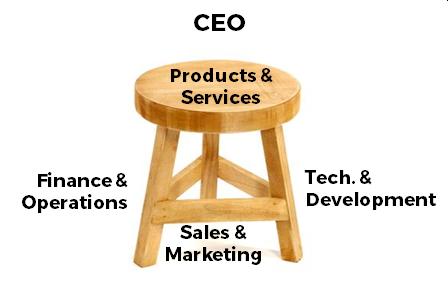When you think of the great successes in businesses – like Pixar, Apple, Microsoft it’s easy to remember the visionary, the driver. However success came from collaboration. The visionary’s success comes from the team around them – Steve Jobs, needed Jony Ive to design his products. Bill Gates needed Steve Bulmer as the sales guy. I often see scale up business struggle with one key growth trap. The don’t have a balanced team:
- The CEO or visionary might believe they have to be the technology leader too – you can’t be everything
- Sales drives the business, which then hits with poor customer service, unfinished products being sold, and sales slow
- Technology drives the business, and the revenue doesn’t follow because the business model hasn’t been put in place
- Noone is really looking after the ‘product’ so the customer buys a ‘product’ and gets given a bespoke solution – great until you have to support multiple unique systems, where the buyer, is looking forward to the product releases pooled from other customers.
The three legged Stool

When you boil down the essence of a business there are three key responsibilities:
- Sales & Marketing – getting your product or service out to the market and closing the deal
- Finance & Operations – making the back-office work well and keep a track on cash and processes
- Technology & Development – The is developing the product, and tools to run the business – be it a physical product (like a Dyson vacuum cleaner), a service (like training), or a digital product (like an app)
There are two glue roles that sit across the legs of the stool
- The CEO – this person promotes the vision and direction of the business. Real personal growth comes from moving from a function lead to a CEO.
- Product & Services – this is the what and the why of the business. The organisation was created to deliver a product or service that people need.
You might ask where other roles like Customer Experience, Supply Chaine or Human Resources fit – since people, logistics, etc are key to the business. They are important to leadership team, and could be part of one of the legs of the stool – such as finance and operations. The 5 key roles are not the exclusive list of management team roles, but are the minimum and still needs to be balanced when other roles are added to the team.
When those five roles are clearly defined and owned by the leadership team the business is balanced.
For example, I worked with one start up where they tried to be agile and each person held multiple hats but their roles overlapped. The marketing lead had each idea cancelled by the sales lead, who then wondered about why the pipeline was failing. The CTO felt they owned the product, and that was only the technology application, which meant the customer experience failed when there were disconnects between operations, the website (marketing) and the app.
So how do I balance my leadership team?
5 tips for balancing your leadership team
- Recognising the pitfalls. The scale up move from a small team around a table where each holds multiple roles, to one where each is a clear role is a hard transition. It can happen when the business is 20 people or 200 people. Often the person who might be interfering and undermining others has no idea; they think they are helping, compensating or being agile.Getting personal coaching could be one part of the solution.
- Knowing your leadership personality types. Diversity means diversity in experience, outlook, thinking and personality. Much conflict comes from different personality styles. Inevitably each of the 5 roles will have different types of people – extroverts and introverts, detail and big picture, people and task. Knowing your style and the styles of others, means that you can move conflict away from personality styles to the issues in the business. Without that diversity, then there is the danger of group think.
- Ensuring there is a clear product management role. This person is the hub of drawing ideas from all teams, shaping the product market fit, and steering the direction of the product. For some companies the product manager is a junior role almost replacing a project manager to ensure delivery happens – however this is a more fundamental role – of turning the business vision into customer experience.
- Confirming roles and responsibilities for the 5 key roles. Using a simple RACI model and agreeing how the management team makes decisions can help make visible the unspoken ways of working.
- Knowing what good looks like for each of the roles. This is where getting part time executive advisors and support can elevate the whole team understand where they need to develop.
For one client, whose business had been running for several years, they had most of the roles in place, but they needed a shift to the next level. They had products, they had tools, and processes but they brought in a portfolio product director AND a portfolio marketing director to reshape thinking. For marketing they took on one of the practitioners of Watertight Marketing. He brought in the tools and thinking to show what good looks like, so that the rest of the team were operating at a new level. These two roles helped balance the business and for the permanent team to continue operating at the next level of thinking for a scale up.

